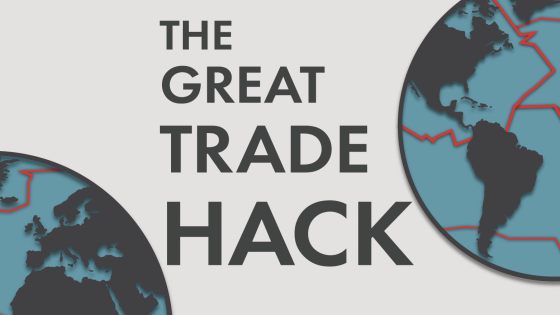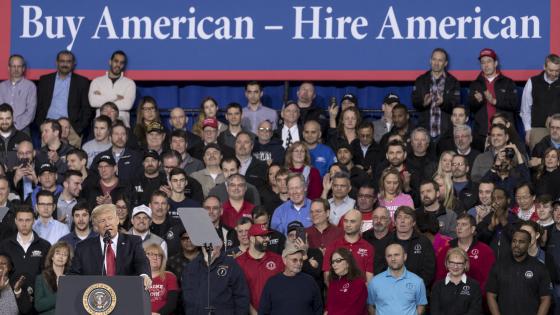Tariffs as symbols, not solutions
But emotionally coherent doesn’t mean economically effective. There is a huge disconnect between what the tariffs are meant to achieve and what they can achieve. Tariffs cannot do all those things. Not won’t. I mean can’t.
- Tariffs can’t fix the deficit. The US buys more from foreigners than it sells since Americans spend more than they produce. In a full employment economy, tariffs can’t fix the spending or the production side of the imbalance.
- Tariffs can’t reindustrialise America. Bringing back industry would require things that tariffs don’t provide, like long-term planning and investments, restored infrastructure, and trained workers.
- Tariffs can’t help the middle class since 90% have service-sector jobs, and you can’t tariff services. Indeed, the tariff-linked price hikes will lower middle-class purchasing power.
Why US protectionism is here to stay
Economically effective solutions – like a Canadian-style social policy – are politically impossible because they would require higher taxes and bigger government. But tariffs are ineffective. Why then are they politically effective? Are they just ‘policy placebos’?
Ironically, tariffs are popular not despite their economic ineffectiveness, but because of it. American protectionism operates like a looping GIF: (1) middle-class malaise creates pressure to act; (2) real solutions are politically toxic; (3) politicians use tariffs to deflect blame; (4) when the tariffs fail to deliver relief, the malaise persists and we are back to step one.
Over the years, both Democrats and Republicans have embraced versions of the Grievance Doctrine – blaming globalisation for the middle class’s struggles. The hesitancy on trade started with Obama, just after the Global Financial Crisis crystallised middle-class anger. Now both parties are trapped in the loop.
American protectionism is the new norm. That’s the new reality we must deal with. On trade, we are in the post-American-leadership era.
Global consequences: The post-American leadership era
Trump’s Hack violated two key principles of the system it had set up. First, by putting different tariffs on different countries, Trump violated rule number one: non-discrimination (most-favoured nation, or MFN). Second, by raising tariffs against everyone, Trump broke all trade promises that America had ever made to anyone anywhere. That violated the principle of tariffs ‘bindings’.
Within a week, the US shifted from being widely regarded as the system’s steward to being widely regarded with suspicion.
The danger now lies not so much in what America has done as what other nations will do going forward. In the 1930s, reckless American tariffs triggered a chain reaction of retaliation that helped spark the Great Depression. Will American recklessness in 2025 do the same?
I think a new 1930s-style collapse is unlikely, and developments since 2 April are encouraging. But a collapse, while unlikely, is not impossible. Two triggers are in plain sight.
The first is the way the US is asking its trade partners to adopt anti-China policies and practices. China, naturally, takes exception to this. If exception turns to anger, and China starts retaliating against these anti-Chinese policies, a new round of trade barriers could go outside of the US.
The second is called ‘trade deflection’. When US tariffs go up, exporters to the US redirect their exports to other countries. Such deflection – in, say, electric vehicles (EVs) – has already inflamed protectionist pressures in third countries. Canada and the EU, for example, have raised tariffs on Chinese EVs. In the book, I call this ‘cascading protection’.
Counterbalancing these new protectionist pressures are new liberalising pressures. Trump’s tariffs are inducing other nations to form new free trade agreements including the UK-India, the UK’s joining of the Comprehensive and Progressive Agreement for Trans-Pacific Partnership (CPTPP), and the China-Brazil agreement. I call this ‘domino liberalisation’.
Here, trade deflection creates a liberalising political force. Exporters that used to sell to the US become keener on selling their goods to other markets. Lower tariffs in other markets would help them do this. This leads them to lobby their government to sign a free trade agreement (FTA) with non-US trade partners. The extra lobbying can lead to new liberalisation. In short, the loss of exports to the US generates pro-FTA forces in nations around the world and the result is more trade deals among non-US countries.
Three scenarios for future global trade relations
The first scenario, Managed Multilateral Drift, is already underway, involving some WTO-compliant raising of tariffs against deflected trade and some WTO-compliant trade liberalisation among third nations (like UK-India, China-Brazil, and British CPTPP accession). In this scenario, regional and bilateral trade deals continue to flourish, and WTO-compliant defensive measures keep trade frictions contained. Importantly, the US remains the sole systemic rule violator. Multilateralism survives but doesn’t thrive.
The second scenario, Fighting Trade Blocs, is like the first but blocs raise tariffs against each other. A likely configuration involves a US-led bloc (with Canada and Mexico as reluctant followers), a China-led bloc, and an EU-led bloc. Here, violation of WTO rules is widespread. This is bad, but not 1930s-style bad.
The third, Reglobalisation Without America, is better for the world but worse for the US. The US continues to wall itself off with high trade barriers and the world gets on without it. American stewardship, in this world, is replaced by ‘leadership herds’ – fluid, informal coalitions aligned by mutual interest in preserving and advancing the system. We have seen these in the past. Japan rallied a herd to rescue the Trans-Pacific Partnership (TPP) after the US withdrew. The EU led another to build the Multi-Party Interim Agreement (MPIA) after the US paralysed the WTO’s Appellate Body. In this future, the WTO evolves into a clearinghouse for cooperation on climate, digital trade, and 21st-century challenges. Multilateralism survives, maybe even thrives.
Here is a summary of the three scenarios:
| Scenario |
Stability |
Role of US |
WTO status |
|---|
| Managed Multilateral Drift |
Moderate |
Marginal |
Survives, diminished |
| Fighting Trade Blocs |
Low |
Defensive |
Sidelined |
| Reglobalisation Without America |
High |
Minor |
Possible revival |
What should world leaders do?
The scenarios I have outlined show what’s at risk. Cascading protection could lead to spiralling tariffs. Domino liberalisation could usher in new trade deals and renewed cooperation. The question is: which way will the world go?
The answer depends on what world leaders do next. In the book, I suggest four actions premised on a key assumption. The old system is not coming back. US protectionism is the default for the foreseeable future.
By July 2025, the scope of Trump’s tariffs will be clearer. A 10% baseline seems likely, with higher penalties for China and possibly the EU. But it is also possible that increasing inflation and a roaring recession cause a backlash and middle-class voters to lose faith in tariff miracles.
- Second, and most important: defend the rules by following the rules.
The WTO is the best firewall against a 1930s-like outcome. WTO-consistent retaliation, such as anti-dumping measures, can provide legal clarity and prevent a spiral into tit-for-tat anarchy.
- Third, negotiate, don’t retaliate.
Only the EU and China are large enough to check US pressure with counter-pressure. But confrontation must follow the rules. Standing up to a bully is necessary. Becoming a bully is not.
- Fourth, keep the door open.
Leave space for an American return. A post-Hack America may seek to rejoin the system. Global prosperity is strongest when the US is inside the house. Best, then, to not lock the door.
- Fifth, renew the system with ‘leadership herds’.’
Trump’s Great Trade Hack revealed not just America’s retreat, but the WTO’s stagnation. For too long, the system has failed to evolve. Key challenges – climate change, AI, digital trade – need new rules. This shock could be the moment for leadership herds to write them.
Closing remarks
My book traces a sobering reality while pointing to a hopeful future. Since US protectionism is structural, and tariffs won’t fix America’s problems, US protectionism is here to stay. This means that the world’s referee has walked off the field, so to speak. The rest of the world must now play on and self-referee because trade isn’t a game – it’s the foundation of global prosperity.
This is possible. America accounts for less than 15% of global commerce. The nations that account for the other 85% can guard the system simply by following the system’s rules. And guard the system they must.
The real cost of Trump’s Great Trade Hack will come if the system falls. And if that happens, we won’t hear a crash – just muffled blows landing on billions of families around the world.




